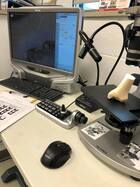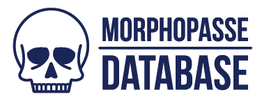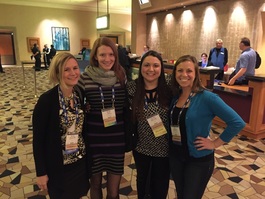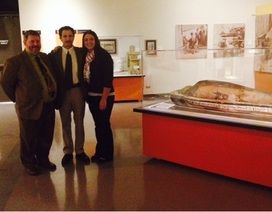
Experimental Analysis of Saw Trauma in Human Bone
The goal of this collaborative project is build upon previous research documenting the frequency of class characteristics to saw trauma in human bone.
In conjunction with Ashley Maxwell at Washburn University, Heather Garvin and Lauren Butaric from Des Moines University, Erin Chapman from the Erie County Medical Examiners Office
The goal of this collaborative project is build upon previous research documenting the frequency of class characteristics to saw trauma in human bone.
In conjunction with Ashley Maxwell at Washburn University, Heather Garvin and Lauren Butaric from Des Moines University, Erin Chapman from the Erie County Medical Examiners Office

Developing a free interactive morphological database for estimating sex in modern adults
The goal of this project is to examine the popular Walker (2008) cranial traits and the Klales et al. (2012) pubis traits from samples originating from diverse temporal and population groups. Both observer error in scoring and asymmetry and its impact on sex classification will also be explored. The culmination of this research will be the creation of a free, interactive computer program for morphological sex estimation that can be used by forensic practitioners for active forensic casework. Forensic scientists will be able to score the eight cranial and pelvic traits in their unknown individual and then use the temporal and population specific equations to predict sex membership with concordant posterior probabilities and accuracy rates.
Website: MorphoPASSE
Funding agency: National Institute of Justice (2015-DN-BX-K014). Note: views expressed here do not necessarily represent the NIJ/DOJ.
Research Fellow: Stephanie J. Cole
The goal of this project is to examine the popular Walker (2008) cranial traits and the Klales et al. (2012) pubis traits from samples originating from diverse temporal and population groups. Both observer error in scoring and asymmetry and its impact on sex classification will also be explored. The culmination of this research will be the creation of a free, interactive computer program for morphological sex estimation that can be used by forensic practitioners for active forensic casework. Forensic scientists will be able to score the eight cranial and pelvic traits in their unknown individual and then use the temporal and population specific equations to predict sex membership with concordant posterior probabilities and accuracy rates.
Website: MorphoPASSE
Funding agency: National Institute of Justice (2015-DN-BX-K014). Note: views expressed here do not necessarily represent the NIJ/DOJ.
Research Fellow: Stephanie J. Cole

Creation of a subadult database with aims to improve age and sex estimation techniques
This ongoing research project, recently funded by the National Institute of Justice (Award 2015-DN-BX- K009), aims to collect subadult data from CT scans in an effort to improve methodological standards associated with subadult remains and to overcome limitations associated with previous projects. Epiphyseal appearance and fusion data, long bone lengths, and pelvic landmark coordinates are being collected from CT scans acquired from modern subadults (ages: birth to 20 years) to develop single and multiple predictor age and sex estimation techniques. This project uses a large, diverse sample of subadult CT scans (n = 1500) collected from two medical examiner offices in the U.S., specifically University of New Mexico Health Sciences Center (UNM) and the Office of the Chief Medical Examiner in Baltimore, Maryland (BMEO). Because the data is being collected from three-dimensional images, the methods developed will be applicable to dry bone specimens and surface scans.
P.I. Kyra Stull, Co-P.I.s Heather Garvin and Alexandra Klales, Research Fellow Michala Stock.
For more information visit Dr. Stull's site: http://kyrastull.weebly.com/
This ongoing research project, recently funded by the National Institute of Justice (Award 2015-DN-BX- K009), aims to collect subadult data from CT scans in an effort to improve methodological standards associated with subadult remains and to overcome limitations associated with previous projects. Epiphyseal appearance and fusion data, long bone lengths, and pelvic landmark coordinates are being collected from CT scans acquired from modern subadults (ages: birth to 20 years) to develop single and multiple predictor age and sex estimation techniques. This project uses a large, diverse sample of subadult CT scans (n = 1500) collected from two medical examiner offices in the U.S., specifically University of New Mexico Health Sciences Center (UNM) and the Office of the Chief Medical Examiner in Baltimore, Maryland (BMEO). Because the data is being collected from three-dimensional images, the methods developed will be applicable to dry bone specimens and surface scans.
P.I. Kyra Stull, Co-P.I.s Heather Garvin and Alexandra Klales, Research Fellow Michala Stock.
For more information visit Dr. Stull's site: http://kyrastull.weebly.com/

CT analysis of Ancient Egyptians from Akhmim Egypt
Robert Hoppa and Jonathan Elias (extension of dissertation research)
This research is the first comprehensive analysis of mummies from the Akhmim region of Egypt and is one of only a few studies that investigates a large mummy collection using a biocultural perspective. The goal of this research is to understand the cultural behavior and population biology of Ancient Egyptians, specifically those from the city of Akhmim. This will be accomplished by systematically evaluating CT scans from a group of Akhmimic mummies in conjunction with the Akhmim Mummy Studies Consortium.
Robert Hoppa and Jonathan Elias (extension of dissertation research)
This research is the first comprehensive analysis of mummies from the Akhmim region of Egypt and is one of only a few studies that investigates a large mummy collection using a biocultural perspective. The goal of this research is to understand the cultural behavior and population biology of Ancient Egyptians, specifically those from the city of Akhmim. This will be accomplished by systematically evaluating CT scans from a group of Akhmimic mummies in conjunction with the Akhmim Mummy Studies Consortium.
|
|
